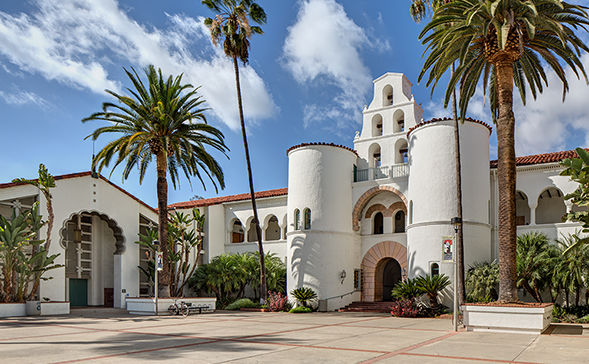Women Who Shaped SDSU
Of the thousands who played a role in university history, these women are particularly noteworthy.

This story appears in the summer 2018 issue of 360: The Magazine of San Diego State University.
The transition from Sally Roush to Adela de la Torre as president of San Diego State University underscores the crucial role that women have played in the university’s history and evolution. In its earliest days as the San Diego Normal School, women formed the majority of the student population. Through the following years, women stepped forward to create new areas of study, lead SDSU’s colleges as academic deans and manage the university’s research and operational budgets. Of the thousands of women who have shaped SDSU over 12 decades, these are among the most influential.
Sally Roush
Sally Roush was president of SDSU for just under 12 months, but her decisions will influence the university for years to come. A universally popular choice for president and a familiar face on campus, Roush served in the Division of Business and Financial Affairs for 31 years, including nearly two decades as senior vice president. She oversaw the university budget and intercollegiate athletics, had a hand in every new building and capital project, and co-chaired the steering committee that guided development of the strategic plan “Building on Excellence.” As president for the 2017-18 academic year, Roush began the planning process for a campus expansion in Mission Valley and—taking student, faculty, alumni and community opinion into account—determined that the university will retain its 93-year-old Aztec identity.
“We will ensure that appropriate recognition of and reverence for the greatness of the Aztec civilization is infused into the daily life of the university,” Roush promised.
Nancy Marlin
President Emeritus Stephen L. Weber recruited Nancy Marlin as SDSU’s first woman provost in 1998. Together, they charted a course to transform SDSU into a global university by increasing academic partnerships with non-U.S. universities and encouraging students to have international experiences. Marlin’s target of 30 percent of undergraduates studying abroad, which once seemed unattainable, is now a reality. SDSU currently ranks No. 8 in the nation for the number of students who study abroad. Marlin also deserves credit for SDSU’s success in significantly reducing not only the time to graduation for all students, but also the achievement gap for underrepresented minority students. Before she stepped down to rejoin the faculty in 2014, Marlin worked to establish SDSU Georgia, which offers internationally accredited undergraduate degrees in the STEM disciplines.
Mary Ruth Carleton
Mary Ruth Carleton led The Campaign for SDSU, the university’s first comprehensive campaign, which exceeded its goal with a record $815 million raised over 10 years. As vice president for University Relations and Development, Carleton supervises SDSU’s government and community relations efforts, marketing and communications, public affairs and alumni relations while serving in the SDSU President’s Cabinet. She is president and chief executive officer of The Campanile Foundation, the board of influential community leaders with responsibility for guiding campaigns and fundraising. Carleton’s significant personal donations to SDSU benefit academics, athletics and student programming. Her leadership has created a “culture of philanthropy” that unites alumni, students, faculty, staff and the San Diego community in support of SDSU.
Vesta C. Muehleisen
An elementary school teacher trained at San Diego Normal School, Vesta C. Muehleisen remained active with her alma mater in ways that resonate for students and alumni today. She earned her undergraduate degree in 1907 with the school’s eighth graduating class. In 1927, San Diego State Teachers College President Edward L. Hardy appointed her to a citizens advisory council charged with helping to find a new site for the institution, then located in Normal Heights. Two previous site selections had fizzled, and the issue was becoming urgent. Muehleisen supported the selection of a then-distant location on a mesa overlooking the east end of Mission Valley and in May 1931, she attended the dedication ceremony for the new campus. In that same year, she founded the San Diego State Alumni Association and became its first president.
Women’s Studies Founders
In 1970, the academic study of women’s experiences and contributions took an enormous step forward at San Diego State with the creation of the first Women’s Studies Program in higher education in the United States. Student Carol Rowell, just returned from a March 1969 conference in San Francisco on sex roles, was determined to do something about the discrimination that she saw pervading “every area of society.” Her discussions with Joyce Nower, an English professor, grew into larger consciousness-raising and “rap” group meetings with participants both on and off campus.
The Women’s Liberation Group, as they called themselves, formed a committee that targeted female faculty members to build support for a new set of women-centered classes. They were an immediate success, and the faculty Senate formally approved the Women’s Studies Program for fall 1970, with six instructors and 10 classes marked by student participation in planning and decision-making. Sexism and pushback against unconventional governance were opposing forces from day one. Additionally, the new program was rocked by internal conflict, and in 1974, the entire faculty and staff resigned.
Without a break, the university tapped Marilyn Boxer, who had been hired to teach women’s history, to chair a revamped and more conventional Women’s Studies Program. It expanded to a full academic department in 1983 and added a master’s program 13 years later.



